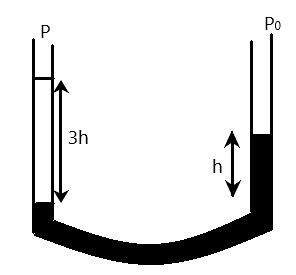
In the given figure shown.

(A) $ P > {P_0} $
(B) $ P < {P_0} $
(C) $ P = {P_0} $
(D) $ P = 0 $

Answer
547.8k+ views
Hint: The diagram given in the question shown is a u tube manometer which measures the pressure of a liquid or gas. The working fluid of a manometer rises at the column of lower pressure.
Complete Step-by-Step solution:
The diagram shown above is that of a u tube manometer. This is a device which is used to find the pressure of a gas or that of a liquid by comparison with the known pressure of the atmosphere.
When both ends of a u tube manometer is simply opened to the atmosphere without any other liquid or gas in any side of the tube but the working fluid, the working fluid will give an equal height on both vertical columns. When a liquid is poured into the tube, the working fluid will rise in the direction of the lower pressure. This is because the added liquid adds to the pressure exerted on the working fluid making it rise up the other column with the lower pressure. If in any way the substance allows the pressure of that column to drop below the atmospheric pressure, then the working fluid will rise up that column.
Hence, from the diagram above, we see that the working fluids rise up the right column.
Hence, $ P > {P_0} $
The correct option is A.
Note:
For clarity, note that the column is balanced when the vertical columns are both exposed because it is the atmospheric pressure that acts on them on both sides of the tube, hence they cancel each other out.
Complete Step-by-Step solution:
The diagram shown above is that of a u tube manometer. This is a device which is used to find the pressure of a gas or that of a liquid by comparison with the known pressure of the atmosphere.
When both ends of a u tube manometer is simply opened to the atmosphere without any other liquid or gas in any side of the tube but the working fluid, the working fluid will give an equal height on both vertical columns. When a liquid is poured into the tube, the working fluid will rise in the direction of the lower pressure. This is because the added liquid adds to the pressure exerted on the working fluid making it rise up the other column with the lower pressure. If in any way the substance allows the pressure of that column to drop below the atmospheric pressure, then the working fluid will rise up that column.
Hence, from the diagram above, we see that the working fluids rise up the right column.
Hence, $ P > {P_0} $
The correct option is A.
Note:
For clarity, note that the column is balanced when the vertical columns are both exposed because it is the atmospheric pressure that acts on them on both sides of the tube, hence they cancel each other out.
Recently Updated Pages
Master Class 11 Economics: Engaging Questions & Answers for Success

Master Class 11 English: Engaging Questions & Answers for Success

Master Class 11 Social Science: Engaging Questions & Answers for Success

Master Class 11 Biology: Engaging Questions & Answers for Success

Class 11 Question and Answer - Your Ultimate Solutions Guide

Master Class 11 Business Studies: Engaging Questions & Answers for Success

Trending doubts
What is meant by exothermic and endothermic reactions class 11 chemistry CBSE

10 examples of friction in our daily life

One Metric ton is equal to kg A 10000 B 1000 C 100 class 11 physics CBSE

Difference Between Prokaryotic Cells and Eukaryotic Cells

What are Quantum numbers Explain the quantum number class 11 chemistry CBSE

1 Quintal is equal to a 110 kg b 10 kg c 100kg d 1000 class 11 physics CBSE




